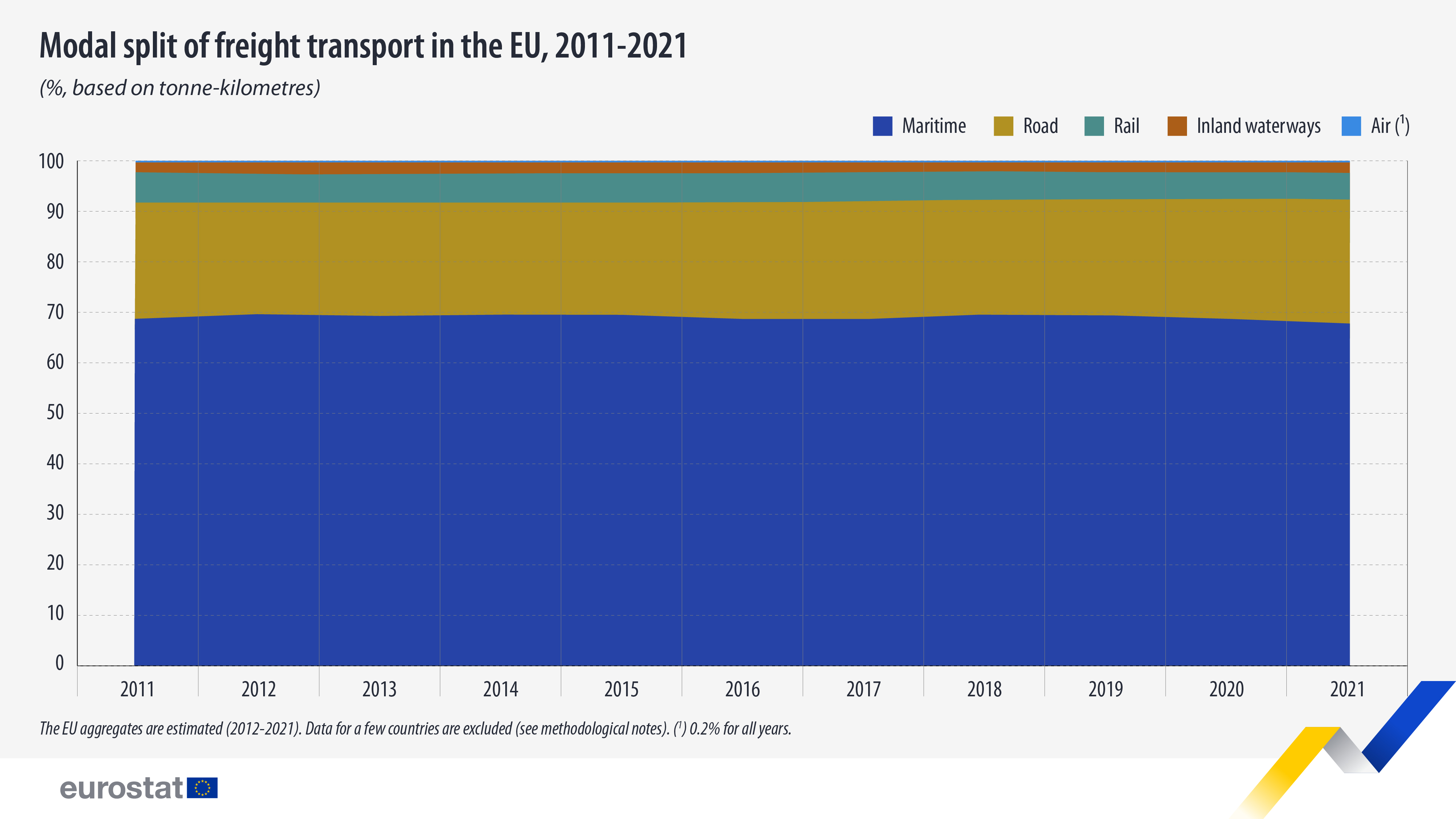Majority of EU freight transport in 2021 via sea

In 2021, maritime transport accounted for more than two-thirds (68%, 5 135 billion tonne-km; tkm) of the EU’s freight transport, the lowest share recorded in the past decade. Road transport accounted for a quarter (25%, 1 863 billion tkm), while rail (5%, 410 billion tkm), inland waterway (2%, 136 billion tkm) and air (0.2%, 15 billion tkm) transport each accounted for small shares of freight transport.
The share of maritime transport decreased slightly compared with 2020 (-1 percentage point; pp). It decreased more significantly compared with the year recording the highest share in the last decade, which was 2012 (-2 pp).
This information comes from data on the modal split of freight transport published by Eurostat today. This article presents a handful of findings from the more detailed Statistics Explained article.
Source dataset: tran_hv_ms_frmod
Meanwhile, the share of road transport in 2021 reached the highest share recorded in the past decade. It increased slightly compared with 2020 (+1 pp) and increased more significantly compared with the year recording the lowest share in the last decade, which was 2012 (+3 pp).
The share of rail transport also slightly increased in 2021 compared with 2020 (+0.2 pp) but remained lower compared with the year recording the highest share in the last decade, which was 2011 (-1 pp).
Inland waterway transport has remained stable since 2018, but slightly lower than the peak recorded in 2013 (-1 pp).
Air had the smallest share in freight transport and remained at 0.2% in the last decade.
Maritime and road transport - main means of freight transport except in Lithuania
Maritime was the main mode of freight transport for 15 EU members (out of 22 with a coastline) in 2021 and accounted for more than 70% of freight transport in 10 countries.
Meanwhile, road transport was the main mode of freight transport for 10 EU members and accounted for more than 70% in three countries: Luxembourg (84%), Czechia (77%) and Poland (70%).
Rail freight transport was the main mode for only one country: Lithuania (53%).
For more information
- Statistics Explained article on freight transport statistics - modal split
- Thematic section on transport
- Database on transport (Theme Transport > Multimodal data > Modal split of transport)
Methodological notes:
- The share of each mode of transport is calculated based on the tonne-kilometres performed by all five modes of transport (road, rail, inland waterways, maritime and air). Therefore, an increase in the share of one mode reflects drops in the shares of other modes but not necessarily drops in transport performance (tonne-kilometres) for other modes. More information can be found in the data on tonne-kilometres by mode of transport.
- Data might not add up to 100% due to rounding.
- EU aggregates for 2012-2021 are estimated due to the following facts:
- Belgium: 2012-2021 data on rail transport are estimated.
- Finland: 2017-2018 data on inland waterway transport are estimated.
- When it comes to data for EU countries, the following notes apply:
- Malta: data on modal split are not available; however, maritime and air transport data are included in the EU aggregates. Data on road freight transport are not available as Malta is exempted from reporting road freight statistics. Malta has no rail and inland waterway transport.
- Cyprus: data on road international transport are not available; however, they are negligible. Cyprus has no rail and inland waterway transport.
- Sweden: 2011-2015 data on inland waterway transport are not available.
- Denmark, Estonia, Ireland, Greece, Spain, Cyprus, Latvia, Malta, Portugal, and Slovenia: no inland waterway freight transport.
- Czechia, Luxembourg, Hungary, Austria and Slovakia: no maritime transport.
If you have any queries, please visit our contact us page.

